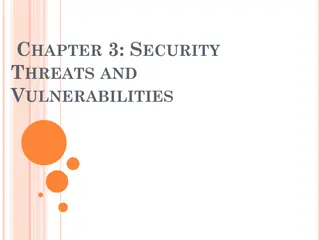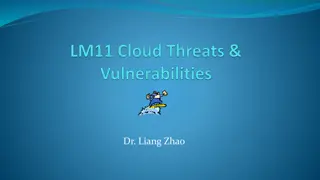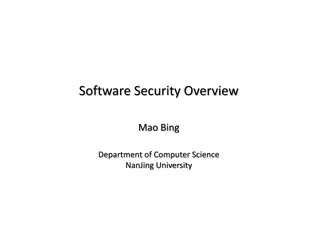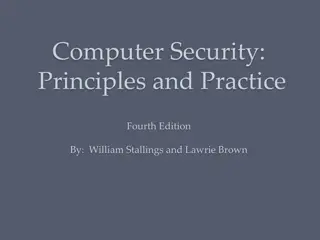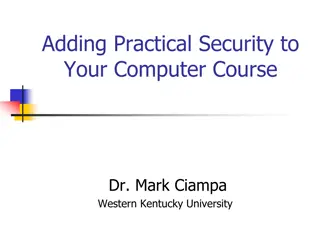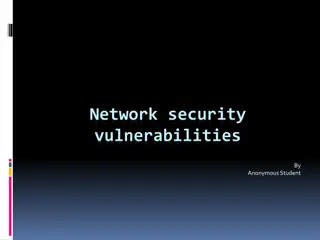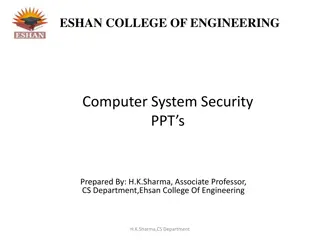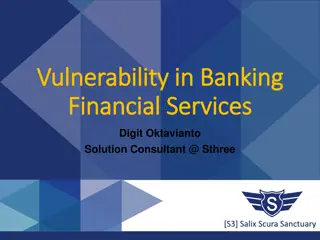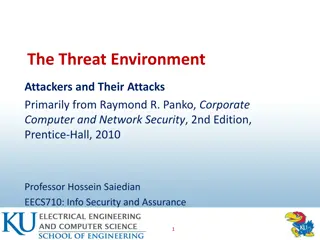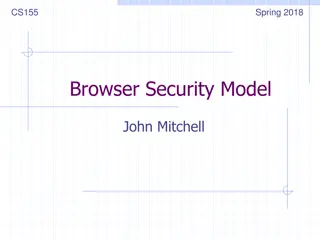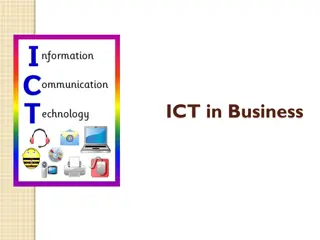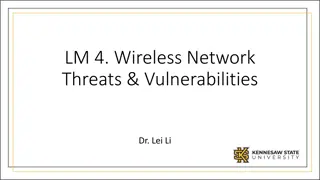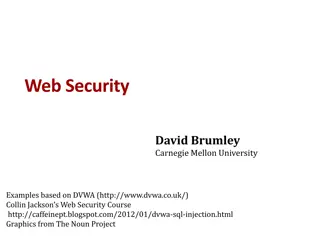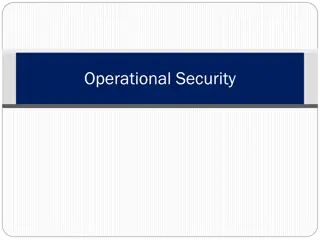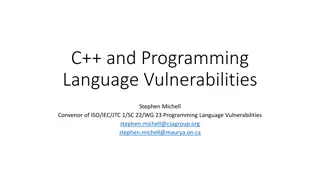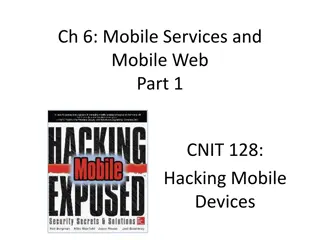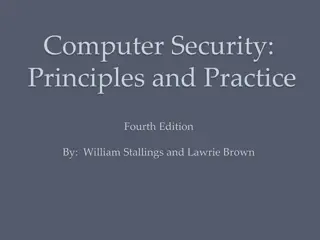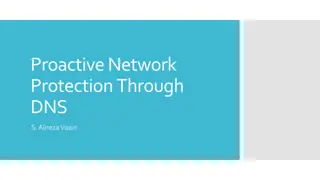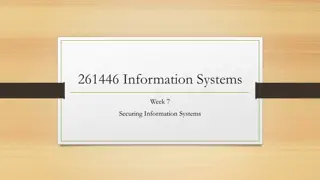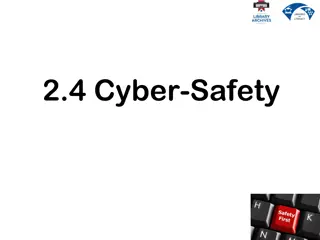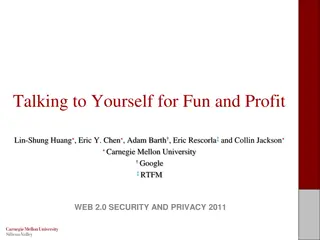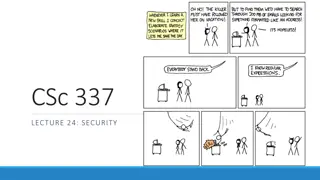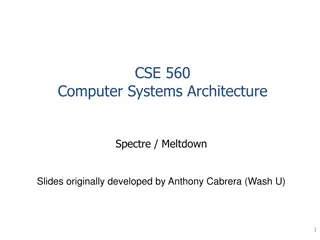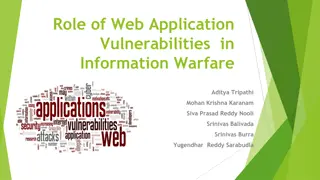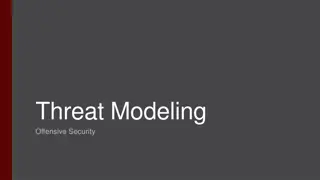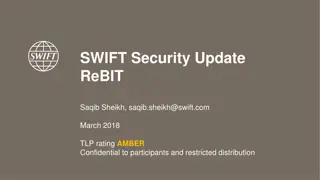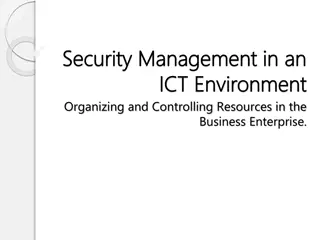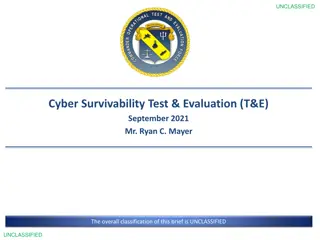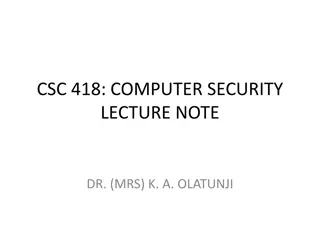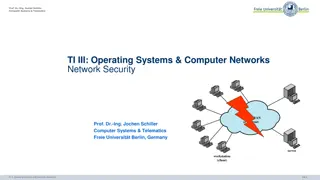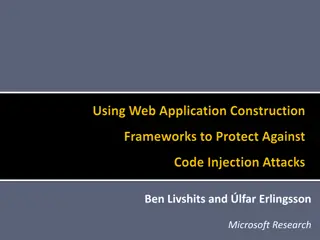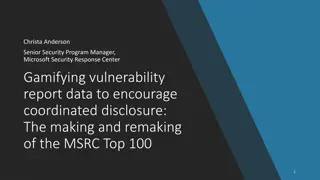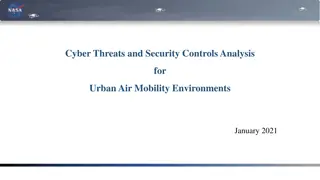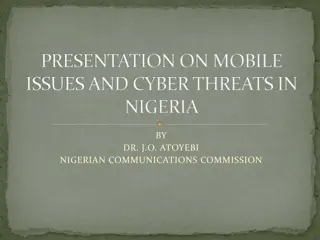Understanding Computer Security Threats and Vulnerabilities
Explore the prevalent computer security issues such as buggy software and gullible users that can be exploited for financial gain. Learn about the marketplace for vulnerabilities, owned machines, and methods attackers use to profit from compromised systems. Discover the motivations behind owning machines, from IP address and bandwidth theft to stealing user credentials for banking, web, and gaming accounts. Stay informed about the risks and dangers in the current state of computer security.
Uploaded on Oct 08, 2024 | 0 Views
Download Presentation

Please find below an Image/Link to download the presentation.
The content on the website is provided AS IS for your information and personal use only. It may not be sold, licensed, or shared on other websites without obtaining consent from the author. Download presentation by click this link. If you encounter any issues during the download, it is possible that the publisher has removed the file from their server.
E N D
Presentation Transcript
CS155 Computer Security Dan Boneh
The computer security problem Two factors: Lots of buggy software (and gullible users) Money can be made from finding and exploiting vulns. 1. Marketplace for vulnerabilities 2. Marketplace for owned machines (PPI) 3. Many methods to profit from owned client machines current state of computer security Dan Boneh
MITRE tracks vulnerability disclosures Cumulative Disclosures Percentage from Web applications 2010 Source: IBM X-Force, Mar 2011 Data: http://cve.mitre.org/ Dan Boneh
Web vs System vulnerabilities XSS peak Dan Boneh
Vulnerable applications being exploited Source: Kaspersky Security Bulletin 2013 Dan Boneh
Introduction Sample attacks Dan Boneh
The computer security problem Two factors: Lots of buggy software (and gullible users) Money can be made from finding and exploiting vulns. 1. Marketplace for vulnerabilities 2. Marketplace for owned machines (PPI) 3. Many methods to profit from owned client machines current state of computer security Dan Boneh
Why own machines: 1. IP address and bandwidth stealing Attacker s goal: look like a random Internet user Use the IP address of infected machine or phone for: Spam (e.g. the storm botnet) Spamalytics: 1:12M pharma spams leads to purchase 1:260K greeting card spams leads to infection Denial of Service: Services: 1 hour (20$), 24 hours (100$) Click fraud (e.g. Clickbot.a) Dan Boneh
Why own machines: 2. Steal user credentials keylog for banking passwords, web passwords, gaming pwds. Example: SilentBanker (and many like it) User requests login page Malware injects Javascript Bank sends login page needed to log in Bank When user submits information, also sent to attacker Similar mechanism used by Zeus botnet Dan Boneh
Why own machines: 3. Spread to isolated systems Example: Stuxtnet Windows infection Siemens PCS 7 SCADA control software on Windows Siemens device controller on isolated network More on this later in course Dan Boneh
Server-side attacks Financial data theft: often credit card numbers Recent example: Target attack (2013), 140M CC numbers stolen Many similar (smaller) attacks since 2000 Political motivation: Aurora, Tunisia Facebook (Feb. 2011) Infect visiting users Dan Boneh
Example: Mpack PHP-based tools installed on compromised web sites Embedded as an iframe on infected page Infects browsers that visit site Features management console provides stats on infection rates Sold for several 100$ Customer care can be purchased, one-year support contract Impact: 500,000 infected sites (compromised via SQL injection) Several defenses: e.g. Google safe browsing Dan Boneh
Insider attacks: example Hidden trap door in Linux (nov 2003) Allows attacker to take over a computer Practically undetectable change (uncovered via CVS logs) Inserted line in wait4() if ((options == (__WCLONE|__WALL)) && (current->uid = 0)) retval = -EINVAL; Looks like a standard error check, but See: http://lwn.net/Articles/57135/ Dan Boneh
Many more examples Access to SIPRnet and a CD-RW: 260,000 cables Wikileaks SysAdmin for city of SF government. Changed passwords, locking out city from router access Inside logic bomb took down 2000 UBS servers Can security technology help? Dan Boneh
Introduction The Marketplace for Vulnerabilities Dan Boneh
Marketplace for Vulnerabilities Option 1: bug bounty programs (many) Google Vulnerability Reward Program: up to 20K $ Microsoft Bounty Program: up to 100K $ Mozilla Bug Bounty program: 500$ - 3000$ Pwn2Own competition: 15K $ Option 2: ZDI, iDefense: 2K 25K $ Dan Boneh
Marketplace for Vulnerabilities Option 3: black market Source: Andy Greenberg (Forbes, 3/23/2012 ) Dan Boneh
Marketplace for owned machines clients spam bot keylogger Pay-per-install (PPI) services PPI operation: 1. Own victim s machine 2. Download and install client s code 3. Charge client PPI service Victims Source: Cabalerro et al. (www.icir.org/vern/papers/ppi-usesec11.pdf) Dan Boneh
Marketplace for owned machines clients spam bot keylogger Cost: US - 100-180$ / 1000 machines PPI service Asia - 7-8$ / 1000 machines Victims Source: Cabalerro et al. (www.icir.org/vern/papers/ppi-usesec11.pdf) Dan Boneh
This course Goals: Be aware of exploit techniques Learn to defend and avoid common exploits Learn to architect secure systems Dan Boneh
This course Part 1: basics (architecting for security) Securing apps, OS, and legacy code. Isolation, authentication, and access control. Part 2: Web security (defending against a web attacker) Building robust web sites, Understanding the browser security model. Part 3: network security (defending against a network attacker) Monitoring and architecting secure networks. Dan Boneh
Dont try this at home ! Dan Boneh
Ken Thompsons clever Trojan Dan Boneh


